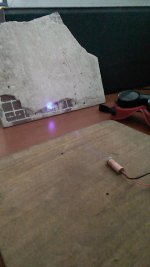dunkelheit_phoenix_2008
Member
- Joined
- Dec 8, 2020
- Messages
- 70
- Points
- 8




It is a continuation of the OP back and forth presented here - https://laserpointerforums.com/thre...-design-for-5v-5a-laser-control.107733/page-3 see posts #34 and prior for background.And that "feedback signal" looks like voltage to the diode, not current through the diode.
You've been told half a dozen times now you need current feedback, and you continue to ignore this.
So it didn't work after all... seems like me and cyp were right.Hello there, I would really appreciate any advice, constructive idea or anything that could be improve on this circuit, it's design for a 4.5A laser diode. Thanks for your help.
View attachment 71863
Hello there, I would really appreciate any advice

Got it, I'll implement a loop for current feedback as a trigger.And that "feedback signal" looks like voltage to the diode, not current through the diode


Stop double posting!I'm using it as a second protection against flyback current, in addition with the reverse internal zener diode of the laser, IRF1404 internal diode allows me to handle that problems, with 60% of efficiency, at leat 121.2 A. Do you consider that this protection is too much? Thanks for add good comments.
Are you saying that I should use another Schotty diode instead Q6? I'll have only one reverse protection (the internal zener of the LD) removing Q6, that's the problem, my inspiration is that I want the system as secure as possible, kind of Alkatraz.You already use 4 different diodes... Don't you think you can reuse any of them, instead of using the parasitic diode of a mosfet as a fifth one?
Is this maybe a joke you make? Was this your inspiration?
View attachment 71891
Then you should use a linear regulator. If your controller glitches/crashes due to outside EMI or whatever else, then the laser can be fed 12V dc. It will be inefficient, but also reliable.I want the system as secure as possible
I've already implemented an EMI/RFI filter in the power supply (the X1 X2 ones), I'm using an exclusive source for the laser, but same ground due communications. Some experiments with LM317 using TIP41C transistors, and LM338 experiments, shown me that linear systems are not good for the laser control. Other point is my dutty cycle is limited at 45% due inverse amplification Q2. You didn't answered my question.Then you should use a linear regulator. If your controller glitches/crashes due to outside EMI or whatever else, then the laser can be fed 12V dc. It will be inefficient, but also reliable.

